OR/14/043 Site description - Cwm Clydach
| Farr, G, Graham, J, and Stratford, C. 2014. Survey, characterisation and condition assessment of Palustriella dominated springs 'H7220 Petrifying springs with tufa formation (Cratoneurion)' in Wales. British Geological Survey Internal Report, OR/14/043. |
Introduction
Cwm Clydach or the Clydach Gorge is a woodland reserve located along a deep limestone gorge, cut by the Afon Clydach. The reserve is part of the Cwm Clydach SSSI and Cwm Clydach Woodlands National Nature Reserve and SAC, and follows the A465 (heads of the valleys road) eastwards from Brynmawr. There are several tufa forming areas associated with Palustriella located along the gorge. If access is gained from Blackrock the first area can be seen to the north of the Afon Clydach just west of the Devils Bridge SO2151112412. During the site visit the Afon Clydach was very high and access to this section was not possible. Walking west another section is located near the mouth of Ogof Clogwyn (SO2133721402) and it is this area that was surveyed for this report. The Ogof Clogwyn site is notable for the occurrence of the two very rare Welsh bryophytes Thamnobryum maderense (only site in Wales) and Orhothecium rufescens (not seen during the present survey) which occurs at only 2 sites in South Wales (Bosanquet & Motley 2013[1]).
Geological and hydrogeological data
In the immediate area of the survey the Clydach Gorge cuts down through the Pembroke Limestone Group of the Carboniferous Limestone, with both the Dowlais Limestone Formation and the Llanelly Formation exposed in the gorge near the survey site. The Carboniferous Twrch Sandstone Formation forms the higher ground to the south and north of the gorge. The Afon Clydach flows from west to east along the base of the gorge also receiving water from the outflow of Ogof Clogwyn (cave) which is a good example of a phreatic cave system and is 165 m in length. The primary water supply mechanisms are diffuse seepages that occurs along the cliff face via joints, bedding planes and fractures within the bedrock and also vertically down the cliff face. In addition water from the discharge at Ogof Clogwyn may also be an important supply albeit only to vegetation immediately around or below the cave entrance.
Part of the water quality sample obtained from Cwm Clydach was lost during transit after being delivered to the NRW bottle store and therefore no information on nutrient levels can be provided.
Land use and pressures
The Clydach Gorge is dominated by natural woodland and is a protected site, visited by walkers, cavers and outdoor sports enthusiasts. There is plenty of evidence of historic industry all around the gorge with old railway lines and quarries associated with the quarrying of lime for construction and agriculture. There is much less industry in the area today however and small villages such as Blackrock and Gellyfelen are nearby. The A465 main road follows the gorge along its northern boundary.
Ogof Clogwyn is a well known cave suitable for beginners so it is possible that there is at least some foot fall in the immediate area of the study site from cavers. There are no grazing animals along the gorge and there is no evidence of poaching. There are few houses in proximity to the study site so abstractions (or discharges) are not thought to be a pressure within the immediate area.
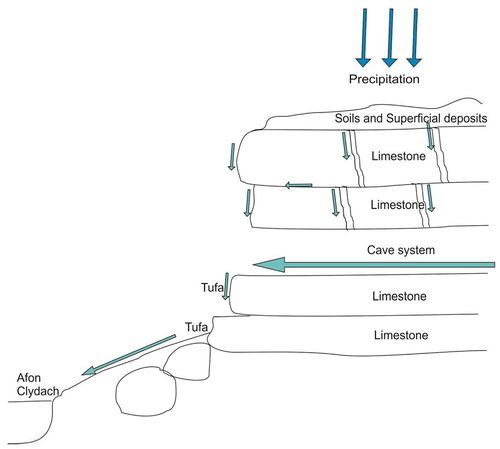
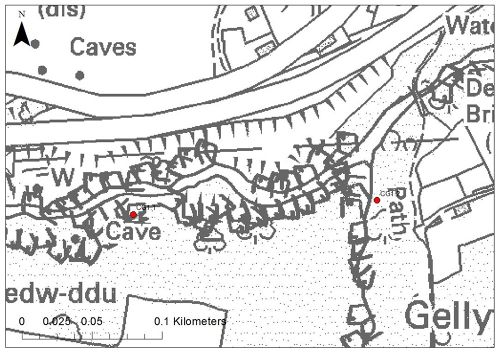
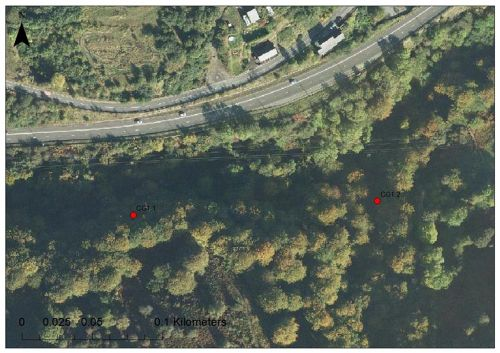
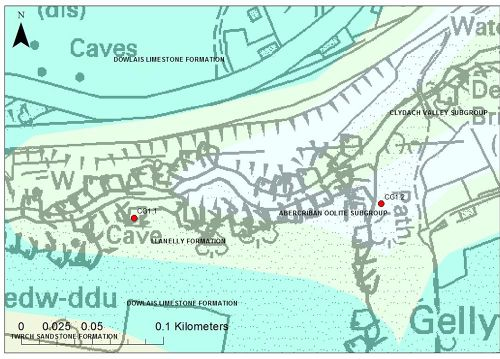
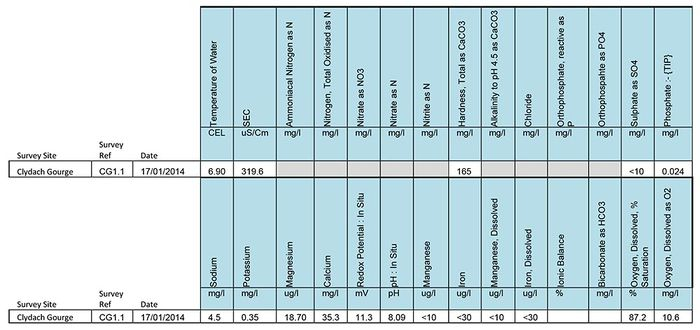
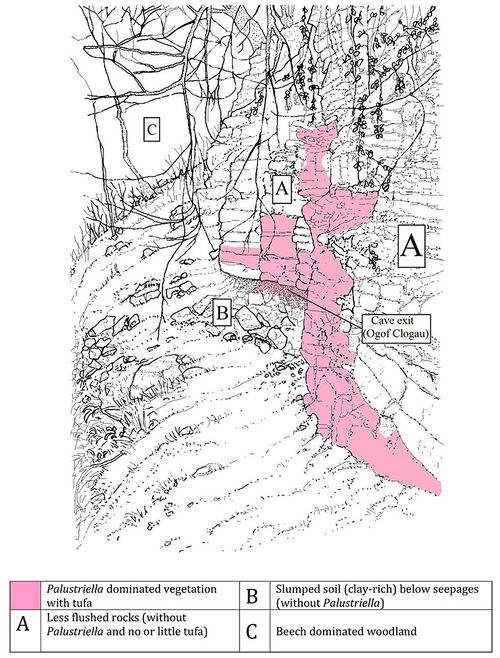
Vegetation (spring) for Cwm Clydach
A vertical shaded and dripping rock face within a wooded gorge that has extensive Palustriella commutata stands towards the base. There are regular sheets of Pellia endiviifolia in shaded rock joints and extensive areas of tufa associated with appressed stands of the liverwort Jungermannia atrovirens and frequent cushions of Eucladium verticiallutum. A range of woodland flowering plants occur in small quantity on the tuferous rock face including Asplenium scolopendrium, Carex sylvatica, Geranium robertianum, Hedera helix and a few tree species. A very wet section of rock face adjoining a small water fall (surveyed during a period of very high rainfall) has patches of Conocephalum conicum and Chrysosplenium oppositifolium.
| Asplenium scolopendrium | O |
| Asplenium trichomanes ssp. trichomanes | R (<1%) |
| Bare rock | F |
| Bryoerythrophyllum recurvirostrum (spor.) | O |
| Carex sylvatica | R (<1%) |
| Chrysosplenium oppositifolium | O |
| Conocephalum conicum | R |
| Conocephalum salebrosum | O |
| Cratoneuron filicinum | O |
| Eucladium verticillatum | A |
| filamentous algae (Chlorophyta) | O |
| Geranium robertianum | R |
| Hedera helix | O |
| Ilex aquifolium (seedling) | R (<1%) |
| Jungermainia atrovirens (non fertile) | O |
| Palustriella commutata | F |
| Pellia endiviifolia | F |
| Rubus fruticosus agg. | R |
| Taxus baccata | R |
Vegetation (adjoining spring) for Cwm Clydach
Bare vertical rock outcrops with locally dominant stands of Neckera crispa with occasional Thamnobryum alopecurum, Ctenidium molluscum, very locally the liverwort Lejeunea lamacerina. Thamnobryum maderense occurs in one place near a cave entrance (Ogof Clogau) beside a small water fall which was prominent during the site visit undertaken during very wet weather.
| Ctenidium molluscum | O |
| Conocephalum salebrosum | O |
| Lejeunea lamacerina | R |
| Neckera crispa | O |
| Thamnobryum alopecurum | O |
| Thamnobryum maderense | R |
Base-rich flushed soil at the base of the bedrock outcrop with frequent Asplenium scolopendrium, Crysosplenium oppositifolium, Fissidens taxifolius var. taxifoluius.
| Asplenium scolopendrium | F |
| Carex sylvatica | R |
| Chrysosplenium oppositifolium | F |
| Fissidens bryoides (spor.) | R |
| Fissidens taxifolius var. taxifolius | F |
| Oxyrrhynchium hians | O |
| Rhynchostegiella pumilla | O |
Beech dominated woodland (top of gorge) with an acidic bryophyte dominated ground flora.
| Agrostis capillaris | O |
| Ctenidium molluscum | O |
| Dicranum majus | R |
| Eurhynchium striatum | O |
| Fagus sylvatica | F |
| Fissidens taxifolius | O |
| Kindbergia praelonga | O |
| Plagiochila asplenioides | O |
| Polytrichum formosum | R |
| Rhytidiadelphis loreus | O |
| Rubus fruticosus agg. | O |
| Leaf litter | A |
Condition assessment
The overall assessment is that Cwm Clydach should be classified as being in favourable ecological and hydrogeological condition.
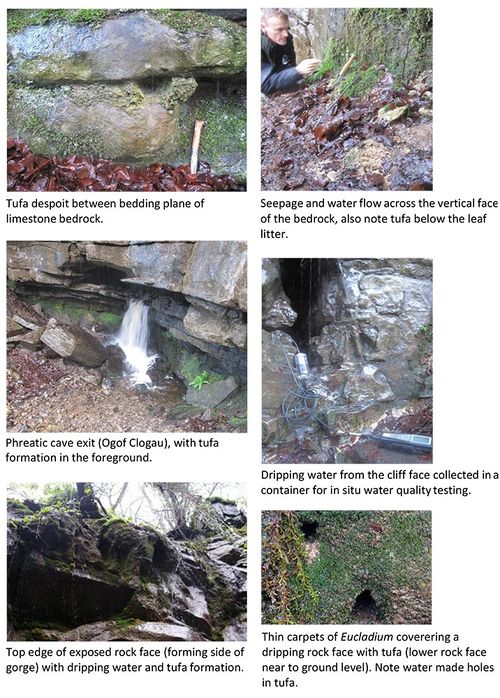
References
- ↑ BOSANQUET, S, and MOTLEY, G S. 2013. A survey of the bryophytes of Cwm Clydach SSSI, Monmouthshire/Breconshire.